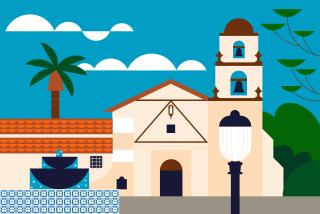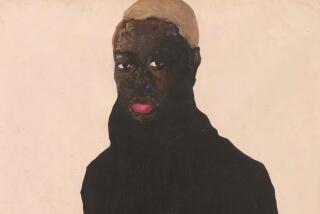Western Artifacts at Ventura Exhibition
- Share via
The Ventura County Historical Museum complements its historical displays--which trace the region from the days when Chumash Indians were its only inhabitants--by rotating a series of exhibits that appeal to a wide variety of cultural interests. Among recent successful showings were “The Golden Age of Carrousels,” which delighted merry-go-round lovers, and an exhibit of Chinese, Japanese and Korean artifacts assembled from private collections throughout Ventura County.
The current exhibit, “Treasures From the Gilcrease Collection,” has attracted hundreds of visitors, many of whom visited this museum, which is operated by the Ventura County Historical Society, for the first time. The 28 paintings and nine bronze sculptures on view are on loan from the Thomas Gilcrease Institute of American History and Art in Tulsa, Okla.
Gilcrease, who was born in Louisiana in 1890, settled in Oklahoma when it was Indian Territory. Oil was discovered on his family’s land and he made a fortune in the burgeoning oil industry. His exposure to the great museums of the world fostered a desire to establish a museum in Oklahoma. Gilcrease spent 25 years amassing a collection of more than 8,000 artifacts, Western paintings, sculpture, and documents relating to the American frontier.
Bronze Sculptures
Represented in the exhibit are paintings and bronze sculptures portraying Indians, cowboys, soldiers and mountain men by such artists as Charles M. Russell, Frederic Remington, James Walker and Charles Schreyvogel. The exhibit, which was funded by Wells Fargo Bank, will be at the museum through Aug. 23.
Another gallery houses the unique George Stuart collection of historical figures. The nearly 200 quarter-life-size figures are rotated in the gallery every four months. Stuart, who lives in Ojai, taught himself to sculpt and work with metal, leather and cloth.
The figures are almost lifelike, a Lilliputian gathering of kings, queens and other famous people in history. It is the authentic detail of these doll-size characters that fascinates visitors: the ruby-studded, gold-embroidered dress worn by the Tudor Henry VIII of England; the miniature gold sword with its jewel-encrusted scabbard, which hangs at the side of the pompous French monarch, Louis XIV; the magnificent gown in which Marie Antoinette must have dazzled the court of husband King Louis XVI of France.
Other halls in the museum trace the county’s past from the Oak Grove people, who archeologists believe lived in Southern California more than 7,000 years ago.
These Indians had learned to use a grinding stone to crush seeds into meal. Juan Rodriguez Cabrillo, the explorer credited with the discovery of California, anchored his two Spanish caravels near present-day Ventura in 1542, encountering Chumash Indian villages in an area that extended from Point Mugu to Santa Barbara County.
Fishermen in Canoes
They were a fishing people who commuted between the Channel Islands in finely crafted wood canoes. The second European to explore California was Spanish navigator Sebastian Vizcaino. His diarist, Father Antonio de la Ascension, commented on the quality of the canoes when he wrote that, since Noah’s Ark, a finer and lighter vessel with timbers better made had not been seen. Visitors may view examples of Chumash basketry that are considered outstanding for their beauty and craftsmanship.
The museum is at 100 E. Main St. in downtown Ventura, across the street from the historic mission. Take the California Street exit off U.S. 101 to Main Street; turn left on Main. Hours are 10 a.m. to 5 p.m. Closed Monday. Information: (805) 653-0323. Admission is free.
More to Read
Sign up for Essential California
The most important California stories and recommendations in your inbox every morning.
You may occasionally receive promotional content from the Los Angeles Times.













